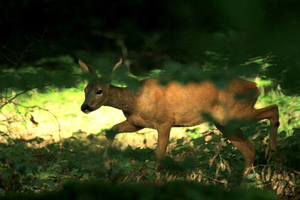
Original Hunting Territory
Bois Landry

Territory for hunting, research and
conservation of forest biodiversity
The monitoring of roe deer populations in an open environment for management purposes has known fundamental developments in the past few years.
The concept of force (number of roe deer present on a given area), impossible to reliably estimate, is has been substituted by the concept of biological indicator or index of ecological change (ICE).
Biological indicators or ICE are measures carried out in a standardised way on roe deer or on their habitat, allowing to evaluate the evolution, in the course of the time, of the sylvo-cynegetic balance , also called the forest-game equilibrium.
In order to set a precedent by responding to the questions of big game hunters, as well as to those from forest owners, while taking into account the administrative constraints and hunting on-the-ground realities, the company Forestis, tenant of the Estate of Bois Landry, has signed in June 2005, a research contract with the National Institute of Agronomic Research (INRA Toulouse - Behavior and ecology of the wildlife).
This contract has allowed for a gradual establishment of a bundle of six ICEs (4 indicators of physical condition of the hunted roe deer, a kilometric indicator of abundance and an indicator of flora consumption).
The use of ICEs on the Estate then allowed to lower the population of roe deer to a level compatible with the forest regeneration and improve the animals' physical condition.
This result has been achieved by the sharp and progressive increase of roe deer extraction, made possible by the administrative framework of the study and the consideration of its results.
Since 2006 the Estate of Bois Landry has an innovative double status of that of a hunting territory as well as of a research territory.
This administrative status of "Experimental Territory" allows the Estate to fit in perfectly into regional policitics, as well as national and European politics for the management and conservation of forest ecosystems and biodiversity.
In 2013, the Estate of Bois Landry, obtained the support of the Région Centre within the actions for protection of forest ecosystems (Ambre).
A new Research Program 2014 / 2015, with two new partners, the CRPF Centre and the Eure et Loir Nature Association was thus launched with new perspectives at the European level until 2020.








